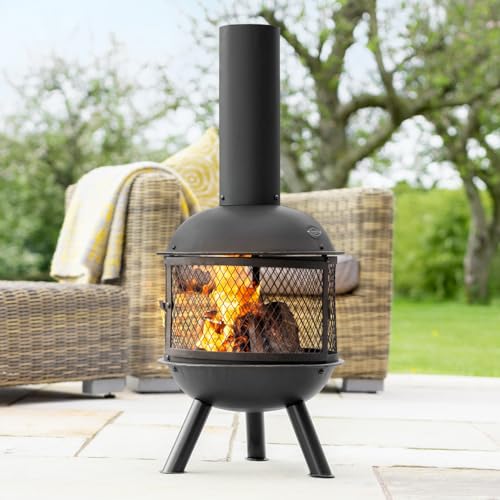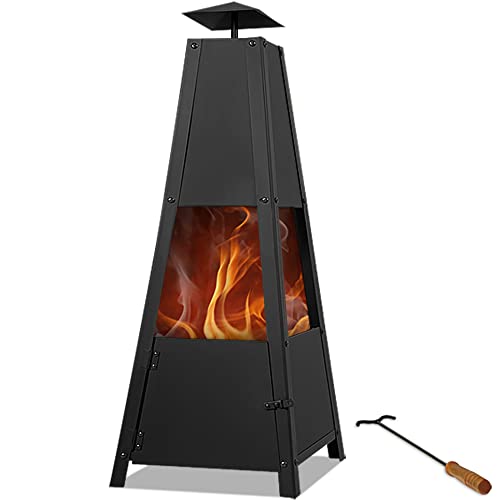Why No One Cares About Ceramic Chiminea
페이지 정보

본문
 The Basics of a Ceramic Chiminea
The Basics of a Ceramic ChimineaThe most common type of chiminea is made of clay. Think terra cotta plant pots or the red pottery ones. Clay is strong and hard, but it can crack when handled incorrectly.
The clay in a chiminea is highly absorbent and needs to be protected with sand or gravel at the bottom along with logs and kindling. This prevents the clay from burning too hot and prevents hairline cracks from becoming.
Materials
The chimineas made of clay (also known as pot-bellied or ovens) feature a chimney that directs smoke upwards. These chimneys are typically glazed to guard against cracking and weathering due to sudden temperature changes. They are still susceptible to sunlight and rain. This makes it essential to keep them covered when not in use, and to ensure that water puddles do not develop within the clay.
The majority of chimineas are made from terracotta clay. Other materials such as cast iron and steel could be used as well. Terracotta offers an authentic Mexican-inspired design, while cast iron and aluminum are strong alternatives that require less care than terracotta. Certain manufacturers also offer contemporary designs that blend the beauty of a clay big chiminea and the toughness of metal chiminea.
Many people choose to pair their chimineas with flowers or evergreen plants. This creates a natural look to complement the ambiance in their backyard. It is essential to carefully choose the right plant combinations, however, because a Chiminea needs to be placed in a location that is free of structures that could catch fire. It is essential to ensure that the chiminea sits in a fire-proof area such as a concrete, brick, or stone patio.
A chiminea is usually constructed by hand from high-fired clay, which might or may not be coated with glaze. The potter is the one who creates the clay. They can make use of the mold of a plaster or potter’s wheel. In either case the clay is then made into a smooth and kneaded form before being allowed to dry. Certain chimineas made of clay are pre-grogged with a substance that can help them withstand thermal stresses that can lead to cracking traditional earthenware.
Other chimineas are made using metal moulds which allow them to be made in a variety of designs and shapes that can be adapted to any backyard. Cast iron chimineas weigh a lot more than clay ones, but they are more durable to the elements and are not as prone to cracking or breaking because of sudden temperature changes like clay. Cast iron chimineas are cheaper than other types, and are available in gas-burning versions for added versatility.
Styles
A chiminea is a fireplace that can be decorated with various styles and materials. Terracotta chimineas are an elegant appearance that has been used for centuries, while metal chimineas are stronger and are able to withstand high temperatures. Many chimineas have decorative patterns and designs that match the furniture of the patio. A rusty patina finish for instance, can give a chiminea a vintage flair, especially when coupled with iron and wood patio furniture.
Chimineas can be freestanding or mounted on a patio that is made of stone, brick or concrete. No matter where you decide to place your chiminea, be sure that it is shielded from wind and from any flammable structures or plants. It is crucial to keep in mind that chimineas can emit smoke and soot that can affect the air quality in the area.
Certain chimineas feature chimneys that open at the lower part of the structure, while others are squat and point upwards. Both models come with or without a large opening to allow for the addition of firewood. The chimneys on squat models are also designed to be shaped in order to create an impressive appearance and enhance the visual appeal.
You can also add decorative elements to the exterior of your chiminea, such as wrought iron, granite, or marble. For an added touch of style, you could consider a ceramic or copper top. These finishes reflect light and increase the look of your chiminea extra large [reference].
A regular chiminea-polish is a good option to protect your outdoor fire pit from damage and enhance it. Utilize olive oil, beeswax or other natural products to polish the surface for an ethereal and glowing finish. Apply a thin layer of the product and rub gently. Rinse and dry your chiminea in order to achieve a radiant finish.
Chimineas can be quite a bit of work, but with the right care and care your chiminea outside will look fashionable for many years. By implementing effective decorating and maintenance techniques, you can enjoy your chiminea in the backyard all through the colder months.
Safety
Although chimineas are popular but they can be dangers to safety if they are not correctly used. Chimineas made of clay are susceptible to cracking, particularly those that aren't glaze-coated. They can also be an ignition source when they are placed too close to flammable materials such as your furniture outside, your home, and the garden. It is best to use a chiminea outside and in an area that is fenced or surrounded by fire-safe materials.
Always keep a fire extinguisher in your home and use it to extinguish small chiminea flames or hot coals that arise while you are tending the flame. You can also use a long lighter to lighting your fire, and move the coals with tongs instead of your hands. A bucket of water is a good thing to have nearby in case the chiminea requires to be snuffed out. It is not recommended to use water to extinguish the chiminea's flame after it has cooled. Instead use water only when the fire has stopped or when the chimney is at risk of bursting.
The draft created by a chiminea could send sparks upwards through the stack, so it is essential to shield your home and neighbors from accidental burns by using a simple spark arrestor made out of chicken wire positioned around the top of the stack. Chimineas also generate a lot of heat and the area around them can become extremely hot, so you should put up a low wall around the chiminea to remind people that getting too close could result in painful burns.
Don't burn your chiminea when it's weather conditions that are windy or rainy. The sparks could cause the chimney to catch fire, which could cause damage to your home. Before using a chiminea, consult your local fire department to confirm that there are no burning bans in place. It is also recommended to clear the area around the chiminea prior to adding firewood, making sure there aren't any objects that could ignite nearby. It is also important to clean the interior of your fireplace after every use. This will prevent the accumulation of ash that could lead to smoke inhalation or even a sooty outdoor.
Maintenance
Despite the fact that they can be used for outdoor fires clay chimineas aren't easy to maintain devices. To ensure their durability, they must be treated exactly the same way as all clay products. This means not allowing them to become too hot and making sure to allow them to cool down between each use. Additionally, they should be regularly cleaned and sealed to prevent the paint from being damaged by moisture.
It is essential to clean the ashes after each use of your chiminea, but only when it has completely cooled. It will remain warm, even if it appears to have cooled, so use the smallest rake and brush to clear away the ash. Once you've swept the ash out and disposed of it carefully the next step is to fill the bottom with gravel or sand. If you don't fill it your chiminea might crack. The clay absorbs moisture and can crack when it becomes too dry.
Some sources recommend sealing the exterior of the chiminea using an acrylic waterproofing agent similar to the ones used to seal tiles. This will stop moisture from causing damage to the chiminea. It is recommended that the chiminea is sanded and resealed every 6 to 8 weeks during periods of heavy use.
Chimineas should only be employed on surfaces that are free of any other coverings or wood. Only using hardwood that has been well-seasoned will lower the amount of sparks and also prevent the clay from cracking.
A chiminea made of clay won't last for a long time. However it is very difficult to break unless you hit it with the force of a Hammer. Cracks can occur for a variety of reasons, such as inadequate burning or a lack of maintenance. They are also prone to rust, so they should be covered when not in use. This will stop snow and rain from corroding metal parts.

- 이전글15 Shocking Facts About Hyundai I20 Replacement Key 24.10.26
- 다음글Where Will Hyundai I10 Remote Key Replacement Be One Year From Today? 24.10.26
댓글목록
등록된 댓글이 없습니다.

